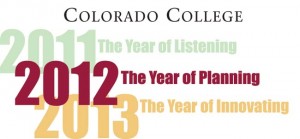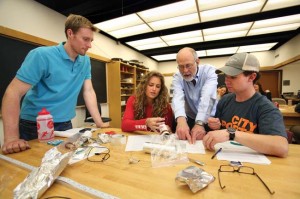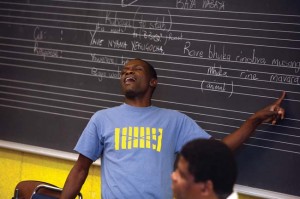 Elliot Mamet, a sophomore at Colorado College and a member of the Extending Our Reach strategic planning committee, offers a visualization of the strategic planning process that is truly fitting, “grounded in the unique character of Colorado College, strategic planning allows us to draw a roadmap of where we are headed and how we are getting there.”
Elliot Mamet, a sophomore at Colorado College and a member of the Extending Our Reach strategic planning committee, offers a visualization of the strategic planning process that is truly fitting, “grounded in the unique character of Colorado College, strategic planning allows us to draw a roadmap of where we are headed and how we are getting there.”
 To avoid being passed on the fast-paced highway of higher education, we at Colorado College need to be able to keep our eyes on the road and our hands on the wheel as we move forward. Keeping our eyes on the road means moving forward while also following the path that has been laid out before us by the established culture and values of the Colorado College community. With our hands on the wheel, we ensure that we’re the ones controlling the direction the college will go as the world changes around us.
To avoid being passed on the fast-paced highway of higher education, we at Colorado College need to be able to keep our eyes on the road and our hands on the wheel as we move forward. Keeping our eyes on the road means moving forward while also following the path that has been laid out before us by the established culture and values of the Colorado College community. With our hands on the wheel, we ensure that we’re the ones controlling the direction the college will go as the world changes around us.
In order to know which direction to go and which path we as a college should take, President Jill Tiefenthaler spent her first year at Colorado College listening to alumni, trustees, faculty, staff, parents, students, and other friends of the college. As a result, President Tiefenthaler gathered a clearer picture of what we do well at CC and what we can build upon. In the Year of Listening, during which she traveled to 13 cities in the United States, the president heard over and over again about the strengths of Colorado College.
Based on the common themes arising out of these conversations, President Tiefenthaler and her staff decided to focus the strategic planning process on three strategies that embody the strengths of Colorado College. The three strategies for the future, each of which is being tackled by a respective strategic planning committee, are:
In addition to these three committees, the strategic planning process also includes the Steering Committee (chaired by President Tiefenthaler), which is focused on directing the overall process, and the Institutional Effectiveness Committee (co-chaired by John Lauer and Stacy Lutz Davidson), which is looking at ways we can prepare the college for change as well as ways we can improve upon the efficiency and effectiveness of CC as an institution.
As is outlined above, each committee has designated one question that is meant to capture the essence and guide the direction of that committee’s outreach to the broader Colorado College community.
As Nathan Lee ’13, who is president of the Colorado College Student Government Association and a member of the Steering Committee, noted, “It’s most important that our vision for the future is one that is shared by the CC community.” The idea, according to student trustee Samantha Barlow ’13, is that “everyone within the CC community will be able to identify with a shared value and a shared goal.”
Each committee has been asked to submit three to five goals to the Steering Committee that is overseeing the strategic planning process; until this point, committee members have been busy conducting individual and group meetings with various constituencies both on and off the CC campus. The committees — which include staff, faculty, students, trustees, alumni, and Colorado Springs community members — used what they heard from the CC community during their outreach to decide upon the goals that were submitted to the Steering Committee.
 The strategic planning process, however, is far from over and the outcome is certainly not yet decided. In fact, the goals that are being sent in to the Steering Committee are meant to capture broad ideals of the CC community and do not designate specific programs or “initiatives,” (understood here as steps that can be taken to accomplish a goal). There is still an opportunity and a significant need for additional input. The final planning document will not be sent to the Board of Trustees for approval until the end of the academic year in May 2013 and your input is both necessary and deeply appreciated at this point in the process.
The strategic planning process, however, is far from over and the outcome is certainly not yet decided. In fact, the goals that are being sent in to the Steering Committee are meant to capture broad ideals of the CC community and do not designate specific programs or “initiatives,” (understood here as steps that can be taken to accomplish a goal). There is still an opportunity and a significant need for additional input. The final planning document will not be sent to the Board of Trustees for approval until the end of the academic year in May 2013 and your input is both necessary and deeply appreciated at this point in the process.
 In addition to responding to outreach emails from the committees and attending strategic planning sessions when possible, these are two other methods for you as a valued member of the CC community to participate in the strategic planning process:
In addition to responding to outreach emails from the committees and attending strategic planning sessions when possible, these are two other methods for you as a valued member of the CC community to participate in the strategic planning process:
Reach out to committee members: The list of committee members, along with extensive documentation of their outreach and the committees’ charges, can be found on each committee’s webpage on the main strategic planning website.
Submit input via the strategic planning webpage: On the main strategic planning webpage, there is a space in which you can offer your suggestions and ideas in response to each of the three questions directing each committee’s outreach.
As we continue to progress and move forward as an institution and as a community, it’s imperative that all community members feel that they’ve been along for the ride, that they are an integral part of this process that’s centered on our plans for the future. Please take the opportunity to get involved since, as chair of the Extending Our Reach committee, Comparative Literature Professor Corinne Scheiner states, “The strategic planning process provides a unique opportunity for all the constituencies of CC — faculty, staff, students, alumni, and parents — to come together as a community, to identify what matters most to us, and to think about how we can support and build on what matters to us as we grow as an institution.”
Get behind the wheel: We need your support.
 As the program coordinator in the President’s Office, Andrew Streight ‘12 staffs two of the strategic planning committees: Extending Our Reach and Institutional Effectiveness.
As the program coordinator in the President’s Office, Andrew Streight ‘12 staffs two of the strategic planning committees: Extending Our Reach and Institutional Effectiveness.
